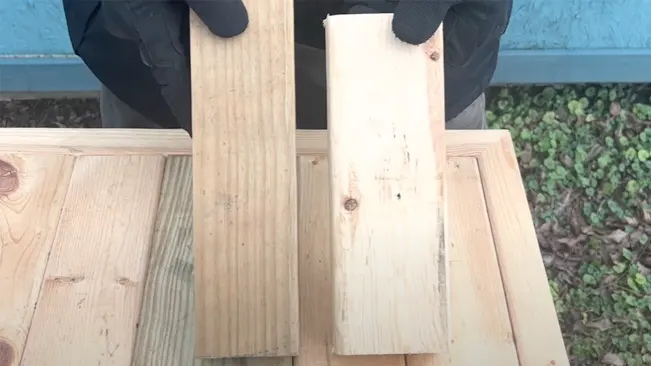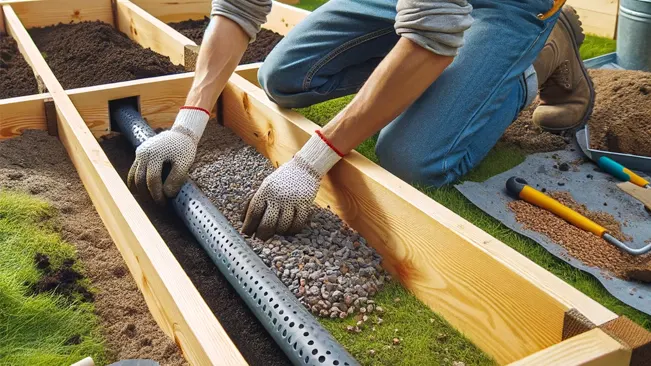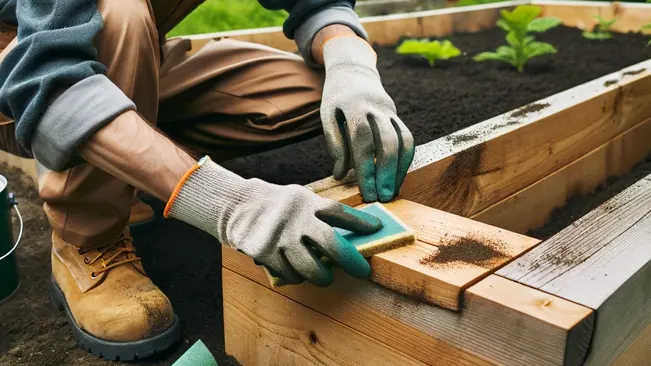Is Treated Wood Safe for Raised Garden Beds? An In-Depth Look
- February 1, 2024
- 0 comment
Gardening enthusiasts and homeowners are increasingly turning to raised garden beds as a solution for growing fruits, vegetables, and flowers. These structures not only offer aesthetic appeal but also provide numerous practical benefits, such as improved soil conditions, better drainage, and easier accessibility. A key consideration in constructing these beds is the choice of material, with treated wood being a popular option due to its durability and resistance to decay.

However, the safety of using treated wood, especially for edible plants, has been a topic of much debate. This article delves into the pros and cons of using treated wood for raised garden beds, offering a comprehensive look at its safety and alternatives.
What is Treated Wood?
Treated wood is lumber that has been processed with chemicals to protect it against pests, fungi, and environmental conditions that cause decay. This treatment extends the life of the wood, making it a cost-effective choice for outdoor structures, including garden beds. However, the chemicals used, such as arsenic in older treatments and copper azole or alkaline copper quaternary (ACQ) in newer options, raise concerns about their potential to leach into the soil and affect plant growth and human health.

Pros and Cons of Treated Wood
Pros
- Treated wood is more resistant to decay, rot, and insect damage compared to untreated wood, making it a durable choice for outdoor garden beds. This longevity can significantly reduce the need for frequent replacements.
- Treated wood withstands harsh weather conditions, including rain, snow, and extreme temperatures, better than untreated wood. This resistance helps maintain the structural integrity of garden beds over time.
- Due to its durability and resistance to elements, treated wood requires less maintenance. Unlike untreated wood, it doesn’t need regular treatments with sealants or other protective coatings to maintain its condition.
- Although the initial cost might be higher, the long lifespan and low maintenance of treated wood can make it a cost-effective option in the long run, saving money on replacements and repairs.
Cons
- The biggest concern with treated wood is the potential for chemicals used in the treatment process to leach into the soil, which could then be absorbed by plants. This is particularly worrisome for beds used to grow edible plants, as it poses a risk to food safety.
- The production and disposal of treated wood have environmental implications. The chemicals used in the treatment process can be harmful to the environment, and disposing of treated wood can be problematic, as it should not be burned or disposed of in regular landfills.
- The upfront cost of treated wood is typically higher than that of untreated wood, which might be a barrier for some gardeners, especially those working within a tight budget or undertaking large projects.
- Handling treated wood requires precautions, such as wearing gloves and masks, to avoid exposure to potentially harmful chemicals. Cutting or drilling treated wood can release these chemicals into the air, posing health risks.
- Treated wood comes in specific types and sizes, which might limit design options for garden beds. Additionally, finding treated wood that is safe for use in gardens, specifically for edible plants, may be more challenging.
Safety for Garden Beds
The safety of using treated wood for raised garden beds is a crucial consideration, especially for beds intended for edible plants. Technological advancements have significantly enhanced the safety of treated woods, reducing the risks associated with older treatments known for containing toxic substances like arsenic. However, concerns about chemical leaching into the soil persist, underscoring the need for gardeners to be well-informed about the types of treated wood they use, focusing on their chemical components and safety standards. Treatments like Alkaline Copper Quaternary (ACQ) and Copper Azole (CA) are considered safer alternatives, yet the risk of chemicals migrating into the soil, though minimal, remains.

To minimize the risk of chemical leaching, a recommended strategy is to line the inside of treated wood garden beds with a heavy-duty plastic barrier, acting as a physical shield between the wood and the soil. This approach is particularly advantageous for beds growing edible plants, effectively reducing the chance of harmful substances being absorbed by the crops. Implementing such protective measures allows gardeners to enjoy the durability and structural benefits of treated wood while safeguarding the health and safety of their garden produce.
Alternatives and Recommendations
When considering alternatives to treated wood for constructing raised garden beds, there are several materials that offer sustainability, safety, and durability. Here are some recommendations:
- Untreated Natural Woods: Woods like cedar and redwood are naturally resistant to rot and pests, making them excellent choices for garden beds without the need for chemical treatment. While they may come with a higher upfront cost, their longevity and safety profile can offer good value over time.
- Composite Decking: Made from a blend of wood fibers and recycled plastics, composite decking materials are durable, resistant to rot and insects, and do not require chemical treatments. They provide an environmentally friendly alternative, leveraging recycled materials for a sustainable gardening solution.
- Galvanized Steel: Galvanized or stainless steel can be used to create durable and stylish garden beds. Steel is highly resistant to rot and pests and can last for many years. However, it’s important to consider that metal can heat up more than other materials, potentially affecting soil temperature.
- Concrete Blocks: Concrete or cinder blocks can be arranged to create a sturdy and durable raised bed. They’re not prone to rot or pests and offer a permanent solution. However, they can be heavy and may require a more involved setup process.
- Bricks: Bricks offer a traditional and aesthetically pleasing option for raised beds. They’re durable and provide excellent resistance to decay. The construction of brick beds might require more effort and potentially mortar to ensure stability.
- Recycled Plastic: Beds made from recycled plastic lumber are an eco-friendly option that resists rot, pests, and weathering. This material can be a bit more expensive but contributes to a circular economy by utilizing recycled materials.
- Stone: Natural stone can create beautiful, durable raised beds that blend well with the landscape. Stones require no maintenance and offer excellent longevity, though constructing stone beds can be labor-intensive and costly.
When choosing materials for raised garden beds, consider factors such as local climate, soil conditions, aesthetic preferences, sustainability goals, and budget. Each material has its unique benefits and considerations, so selecting the right one depends on your specific gardening needs and priorities.
Installation Tips
Ensuring the proper installation of treated wood garden beds is paramount not only for their longevity but also for maintaining safety within your gardening space. Key to this process is the implementation of effective drainage systems within the beds, which prevents water from pooling and potentially leading to root rot or fungal diseases in your plants. Equally important is the strategic placement of these garden beds to avoid direct contact with external water sources, such as sprinkler systems or natural runoff paths, which could exacerbate moisture accumulation and lead to the premature decay of the wood.

Additionally, the use of high-quality, corrosion-resistant hardware—such as galvanized or stainless steel screws and brackets—is essential in constructing your garden beds. These materials ensure the structural integrity of the beds over time, resisting the wear and tear caused by exposure to the elements and the chemical treatments within the wood. By paying close attention to these critical aspects of installation, gardeners can create durable and safe environments for their plants to thrive, maximizing the benefits of using treated wood in garden bed construction.
Maintenance
Performing regular maintenance checks on your garden beds plays a critical role in identifying early signs of deterioration, such as rot, or the possibility of chemical substances leaching into the soil. These inspections allow gardeners to take swift action, replacing any damaged sections of the wood to prevent further decay and to preserve the overall stability and safety of the raised beds. By keeping a vigilant eye on the condition of the garden beds and addressing issues as soon as they arise, gardeners can ensure the longevity of their garden structures.

This proactive approach not only safeguards the structural integrity of the raised beds but also contributes to a healthier, more vibrant garden by minimizing the risk of plant exposure to potentially harmful chemicals and by preventing plant damage due to weakened support structures.
Related Topics
- How to Construct a Charming Wood Garden Gate: A Beginner-Friendly Guide
- How to Shield Garden Bed Wood: Effective Protection Strategies
Conclusion
The use of treated wood in raised garden beds presents a balance between durability and safety concerns. With modern treatments deemed safer and precautions like lining the beds, gardeners can mitigate most risks. However, understanding the materials and their impact on your garden and health is crucial before making a decision. By considering the pros and cons and exploring alternatives, you can create a garden that is not only beautiful and productive but also safe.
FAQs
- What is treated wood and why is it used in raised garden beds?
Treated wood is lumber that has been treated with chemicals to protect it against decay, pests, and weather, making it a popular choice for outdoor projects like raised garden beds due to its durability. - Are the chemicals used in treated wood safe for growing edible plants?
The safety of growing edible plants in treated wood beds depends on the type of chemicals used in the treatment process. Newer treatments are considered safer than older, arsenic-based treatments, but it’s essential to know the specific chemicals used in your wood. - Can chemicals from treated wood leach into the soil and plants?
There is a possibility that chemicals from treated wood can leach into the soil, especially in older treated woods, but the risk is significantly lower with newer treated wood options designed to minimize such leaching. - What precautions can I take to safely use treated wood for my garden beds?
To minimize risks, consider lining the inside of treated wood beds with a protective barrier, choosing wood treated with safer, newer chemicals, and ensuring good drainage to reduce soil contact with the wood. - How long does treated wood last when used for raised garden beds?
Treated wood can last for many years, often over a decade, in raised garden beds due to its resistance to rot and decay, making it a long-lasting option for garden structures. - Are there any environmentally friendly alternatives to treated wood for garden beds?
Yes, alternatives like cedar and redwood offer natural resistance to decay without the need for chemical treatment, and recycled composite materials are also a sustainable choice. - How does the cost of treated wood compare to other materials for garden beds?
Treated wood tends to be more expensive upfront than untreated wood but may offer cost savings over time due to its longer lifespan and reduced maintenance needs. - Can I use old treated wood for raised garden beds?
It’s advisable to be cautious with old treated wood, especially if it was treated before 2004, as it might contain harmful arsenic-based chemicals. Newer treated wood is generally safer. - How can I identify the type of treatment used on wood for garden beds?
Look for stamps or labels on the wood that indicate the type of chemical treatment used. If in doubt, consult with the supplier or choose wood with clearly marked safe treatment options. - What maintenance is required for treated wood garden beds to ensure safety and durability? Regular inspections for signs of wear or damage, replacing any compromised wood, and ensuring good drainage can help maintain the safety and longevity of treated wood garden beds.
What are your thoughts on using treated wood for raised garden beds? Have you used it in your garden, or do you prefer alternative materials? Share your experiences and insights in the comments below—we’d love to hear from you and learn together!

Charles Hayes
Forestry AuthorI'm Charles Hayes, I bring over 15 years of specialized expertise in landscaping and woodworking, blending artistic design with sustainable environmental stewardship. My career, fueled by a profound passion for the natural world, encompasses extensive education and hands-on experience in creating harmonious, eco-friendly outdoor spaces and responsibly managing forest resources. Recognized for my professional standing, I am committed to continuous learning and certification in cutting-edge practices. My expertise is not only reflected in my work but also in my contributions to community projects, educational workshops, and collaborations with industry leaders. As an authoritative voice in my field, I strive to share knowledge and promote environmentally conscious approaches, making me a trusted resource in landscaping and forestry.













Leave your comment